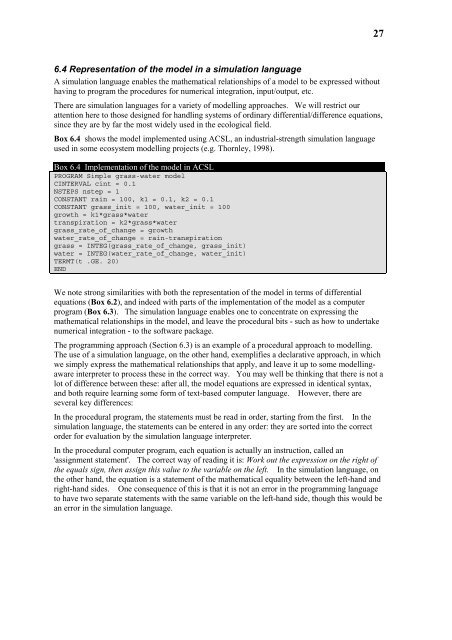pdf: 600KB - Potsdam Institute for Climate Impact Research
pdf: 600KB - Potsdam Institute for Climate Impact Research
pdf: 600KB - Potsdam Institute for Climate Impact Research
Create successful ePaper yourself
Turn your PDF publications into a flip-book with our unique Google optimized e-Paper software.
27<br />
6.4 Representation of the model in a simulation language<br />
A simulation language enables the mathematical relationships of a model to be expressed without<br />
having to program the procedures <strong>for</strong> numerical integration, input/output, etc.<br />
There are simulation languages <strong>for</strong> a variety of modelling approaches. We will restrict our<br />
attention here to those designed <strong>for</strong> handling systems of ordinary differential/difference equations,<br />
since they are by far the most widely used in the ecological field.<br />
Box 6.4 shows the model implemented using ACSL, an industrial-strength simulation language<br />
used in some ecosystem modelling projects (e.g. Thornley, 1998).<br />
Box 6.4 Implementation of the model in ACSL<br />
PROGRAM Simple grass-water model<br />
CINTERVAL cint = 0.1<br />
NSTEPS nstep = 1<br />
CONSTANT rain = 100, k1 = 0.1, k2 = 0.1<br />
CONSTANT grass_init = 100, water_init = 100<br />
growth = k1*grass*water<br />
transpiration = k2*grass*water<br />
grass_rate_of_change = growth<br />
water_rate_of_change = rain-transpiration<br />
grass = INTEG(grass_rate_of_change, grass_init)<br />
water = INTEG(water_rate_of_change, water_init)<br />
TERMT(t .GE. 20)<br />
END<br />
We note strong similarities with both the representation of the model in terms of differential<br />
equations (Box 6.2), and indeed with parts of the implementation of the model as a computer<br />
program (Box 6.3). The simulation language enables one to concentrate on expressing the<br />
mathematical relationships in the model, and leave the procedural bits - such as how to undertake<br />
numerical integration - to the software package.<br />
The programming approach (Section 6.3) is an example of a procedural approach to modelling.<br />
The use of a simulation language, on the other hand, exemplifies a declarative approach, in which<br />
we simply express the mathematical relationships that apply, and leave it up to some modellingaware<br />
interpreter to process these in the correct way. You may well be thinking that there is not a<br />
lot of difference between these: after all, the model equations are expressed in identical syntax,<br />
and both require learning some <strong>for</strong>m of text-based computer language. However, there are<br />
several key differences:<br />
In the procedural program, the statements must be read in order, starting from the first. In the<br />
simulation language, the statements can be entered in any order: they are sorted into the correct<br />
order <strong>for</strong> evaluation by the simulation language interpreter.<br />
In the procedural computer program, each equation is actually an instruction, called an<br />
'assignment statement'. The correct way of reading it is: Work out the expression on the right of<br />
the equals sign, then assign this value to the variable on the left. In the simulation language, on<br />
the other hand, the equation is a statement of the mathematical equality between the left-hand and<br />
right-hand sides. One consequence of this is that it is not an error in the programming language<br />
to have two separate statements with the same variable on the left-hand side, though this would be<br />
an error in the simulation language.
















